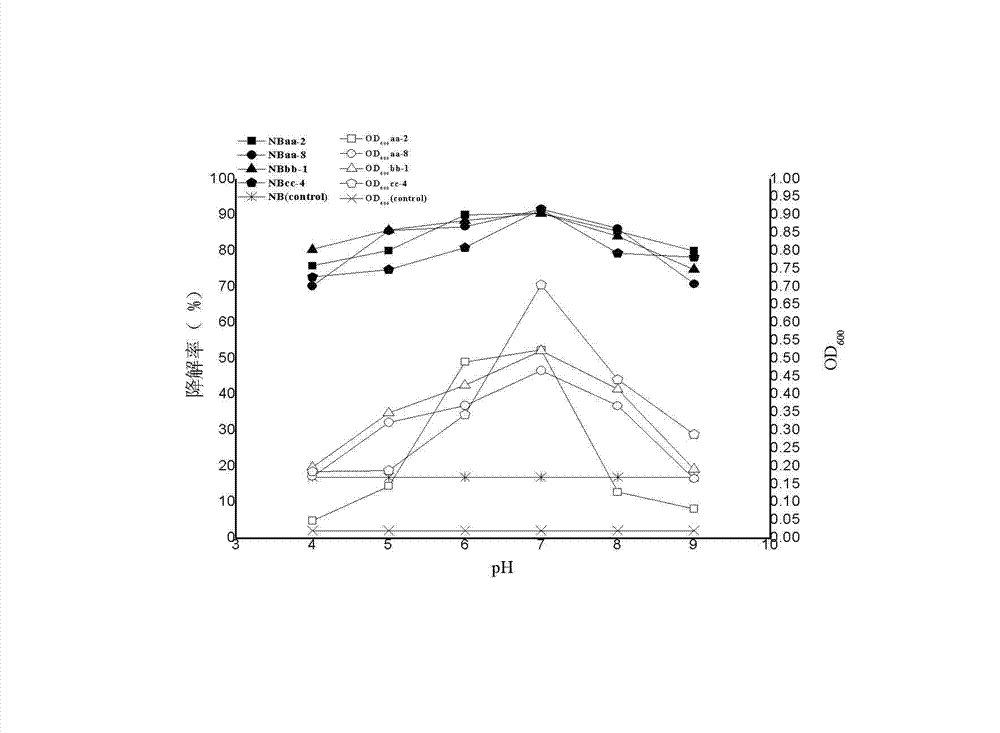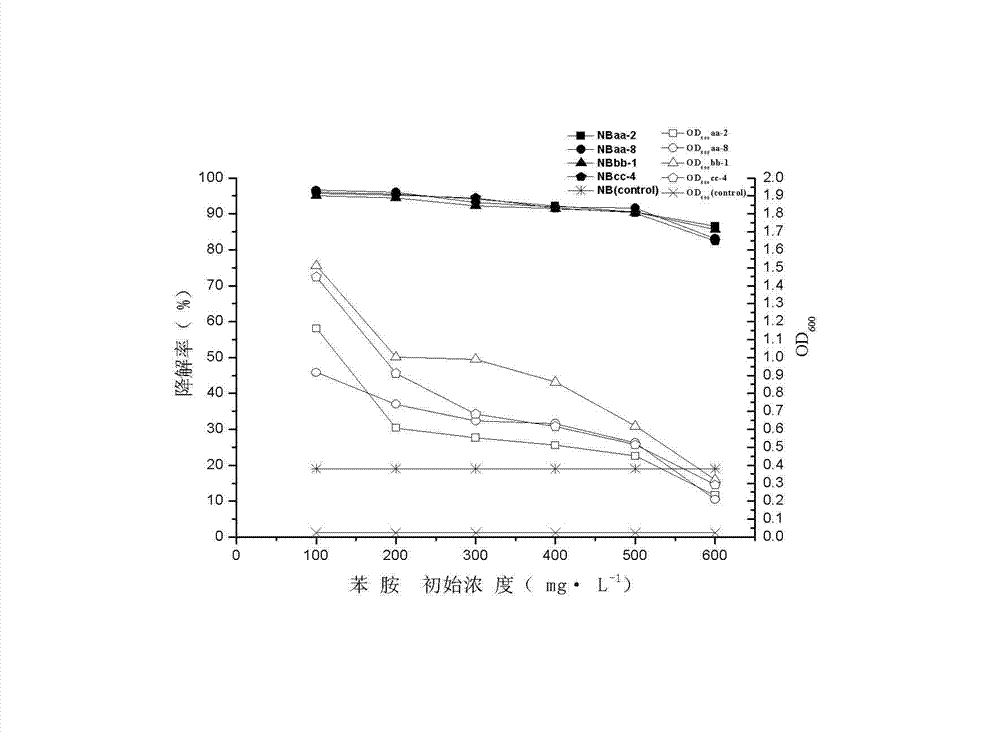Method for degrading phenylamine in waste water
A waste water and aniline technology, applied in chemical instruments and methods, water pollutants, biological water/sewage treatment, etc., can solve the problems of aniline degradation and inability to achieve the effect of low cost and guaranteed degradation rate
- Summary
- Abstract
- Description
- Claims
- Application Information
AI Technical Summary
Problems solved by technology
Method used
Image
Examples
Embodiment 1
[0017] Example 1 The acquisition of aniline salt-tolerant bacteria
[0018] Methods as below:
[0019] (1) The activated sludge polluted by aniline was enriched and cultured at a temperature of 30°C and 150r / min for 48 hours to obtain an enriched liquid, and the supernatant was diluted in gradient and spread on the beef extract peptone solid medium;
[0020] (2) Acclimatization of aniline resistance ability: inoculate the enriched bacterial liquid on the inorganic salt medium containing saturated aniline solution (ammonium sulfate 0.5g, potassium dihydrogen phosphate 0.5g, sodium chloride 0.5g, ammonium chloride 1g, magnesium sulfate 0.632g, made into 1000ml with distilled water) to domesticate the aniline-resistant ability of the strain, after 48 hours of cultivation, transfer the bacterial liquid to a fresh liquid inorganic salt medium, and gradually increase the aniline concentration during the domestication process, gradually increasing from 50mg / L to 500mg / L;
[0021]...
Embodiment 2
[0026] Example 2 The influence of pH value on the degradation performance of aniline
[0027] Method: The suspensions of four aniline salt-tolerant strains in the logarithmic growth phase were inoculated at 10% (v / v) to pH values of 4.0, 5.0, 6.0, 7.0, 8.0, and 9.0, respectively. In the aniline inorganic salt medium of L (ammonium sulfate 0.5g, potassium dihydrogen phosphate 0.5g, sodium chloride 0.5g, ammonium chloride 1g, magnesium sulfate 0.632g, made into 1000ml with distilled water), the salinity is 10%, Shake culture at 30°C and 150 r / min for 48 hours, measure the degradation rate of aniline after 48 hours, and use photoelectric turbidimetry to measure the growth of the strain. The degradation results are as follows: figure 1 .
[0028] like figure 1 As shown, the four strains grow best when the pH value is 7.0, and when the pH value is 7.0, the degradation rate of aniline reaches the highest, and the preferred pH value of the method of the present invention is 7.0...
Embodiment 3
[0029] Example 3 Effect of initial concentration of aniline on the degradation performance of aniline
[0030] Method: The suspensions of four aniline-salt-tolerant strains in the logarithmic growth phase were inoculated at 10% (v / v) in the aniline inorganic Salt medium (ammonium sulfate 0.5g, potassium dihydrogen phosphate 0.5g, sodium chloride 0.5g, ammonium chloride 1g, magnesium sulfate 0.632g, made into 1000ml with distilled water), the salinity is 10%, at 30℃, Under the conditions of pH=7 and 150r / min, shake culture for 48h. Measure the aniline degradation rate of 48h, utilize photoelectric turbidimetry to measure the growth situation of bacterial strain simultaneously, degradation result is as follows figure 2 .
[0031] like figure 2 As shown, the degradation rate of aniline by the strains decreased with the increase of the initial concentration of aniline, and the growth values of the four strains all began to decline when the aniline concentration exceeded 5...
PUM
| Property | Measurement | Unit |
|---|---|---|
| salt tolerance | aaaaa | aaaaa |
Abstract
Description
Claims
Application Information
 Login to View More
Login to View More - R&D
- Intellectual Property
- Life Sciences
- Materials
- Tech Scout
- Unparalleled Data Quality
- Higher Quality Content
- 60% Fewer Hallucinations
Browse by: Latest US Patents, China's latest patents, Technical Efficacy Thesaurus, Application Domain, Technology Topic, Popular Technical Reports.
© 2025 PatSnap. All rights reserved.Legal|Privacy policy|Modern Slavery Act Transparency Statement|Sitemap|About US| Contact US: help@patsnap.com



